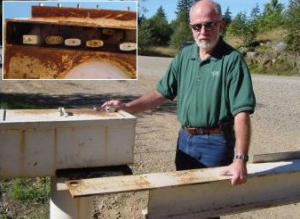Site Security FLAP: F is for Fences

[June 2014] Without a secure transmitter site, a broadcast station cannot properly maintain its on-air operations. That is why protection from everything from lightning to vandalism and theft is a high priority. As to the latter, Kevin Kidd has some good suggestions to share. He hopes you will FLAP, too.
Let us start with an obvious statement: every station has considerable funds invested in the transmitter site, both the building and ground systems. And, here is another obvious statement: unless you take precautions, it is not if but when metal thieves will attack your site.
Comex Copper monthly averages have been fairly flat in the $3.10 – $3.40 per pound range for a year or more. Yet, even as the Comex price for new shiny copper has slowly receded, scrap prices have stayed at stunning, historically high percentages of the Comex price – in fact, scrap is selling for over double the new wire wholesale cost paid just a few years ago.
Taken together, the obvious conclusion is that now is the time to assess your situation and implement security strategies before loss occurs.
Protect Your Site
Fences are the primary line of protection for any site. In this article, we will discuss the components of an effective fence.
It has been said: “good fences make good neighbors.” This is because fences delineate specific boundaries, and most people respect boundaries to some extent.
Of course, the more isolated a site may be, the stronger these boundaries need to be to discourage trespassers.
Tower and Property Fences
FCC rule 73.49 specifies “Antenna towers having radio frequency potential at the base (series fed, folded unipole, and insulated base antennas) must be enclosed within effective locked fences or other enclosures. Ready access must be provided to each antenna tower base for meter reading and maintenance purposes at all times. However, individual tower fences need not be installed if the towers are contained within a protective property fence.”
There is a lot of discussion about exactly what constitutes an “effective” fence from the FCC viewpoint. Even the FCC Staff appears to have varying opinions and no exact specification of what constitutes “effective” fencing. A lock is absolutely necessary. A gate is absolutely necessary. The keys may not be lying in full view on top of the gatepost, as one local licensee discovered a few years ago.
But – from a security standpoint – site perimeter and tower fencing must be tall and substantial enough to discourage climbing over, crawling under or cutting thru.
How High?
How high does a fence need to be? Typically you should plan for a minimum of six to eight feet of commercial grade chain link fabric with tension bars and/or wires.
Recent security studies show replacing the fabric’s top tension bar with a tension wire eliminates the hand hold the bar produces. The tension bar can then be moved to the bottom of the fabric to discourage attempts to crawl under the fabric and the fence.
Of course, it is absolutely essential to keep overgrowth away from both sides of all fencing. If you give a thief someplace to hide it will defeat otherwise good security precautions. The proper distance will depend upon factors like how far the fence is from a roadway, sightlines, or if there is motion sensing video monitoring. In any event, I would suggest at least six to ten feet of clearance of both sides of the fence.
Harder to Climb
High security fabric is available as an option.
This fabric has much smaller, heavier webbing and is supposedly nearly impossible to climb. For purposes of evaluation, this fat-bald-halfcentury-old engineer personally tried and failed to climb ten feet of the high security fabric.
But then again, this much younger, not-quite-asfat-but-mostly-bald engineer tried and failed to clear a two-foot electric fence around a watermelon patch a number of years ago. However, I have effectively blocked the incident from my memory and currently refuse to acknowledge any reference to the incident or related police reports. (Friends just call me Sparky. My Native American friends call me “Dances Like Fool Straddling a Hot Wire Wearing Shorts on a Sweaty Southern Night.”)
My distinct lack of athleticism aside, it is clear that the small weave fabric is much harder to climb than the normal material.
Effective and Legal
If a fence is built substantially enough so that it can “effectively” keep a drug-deprived lunatic out, it should satisfy the humble public servant in the form of an FCC inspector. As an additional deterrent, several strands of barbed wire or razor wire should be located atop the chain link fabric.
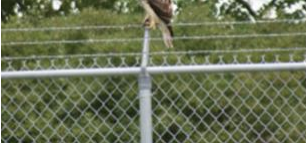
Barbed wire should top a fence, but sometimes razor wire is a better solution
We rebuilt a site which had suffered extensive vandalism. The new owners had installed sixfoot chain link perimeter fencing, but no barbed wire. While working on the site, we witnessed dozens of people of every age group climb the new fence, run across the narrow site, climb a similar fence on the other side and disappear into the safe confines of the local Walmart.
On the other hand, when some barbed wire was added, it reportedly slowed the traffic across the site.
By the way, we do recommend that barbed wire arms be bolted or riveted to the post to keep a vandal from lifting the arm off the post top.
Secure the Hardware
V-arm barb wire supports (sometimes called Double Layer) should be considered for sites with higher security concerns.
This type of barbwire supports puts a layer of barbed wire angled to the outside and an additional layer angled toward the inside of the fence. Extremely challenged sites may require a second layer of fencing spaced 10 to 20 feet inside the initial perimeter fence.
To prevent easy access from trespassers using common hand tools, all hardware must be mounted such that it is not easily accessible from outside the fenced area – and it should be peened.
Using Electrified Fences
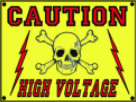 Many of us engineering types have had fantasies of hooking up the transmitter plate supply to the fence in an effort to protect our properties.
Many of us engineering types have had fantasies of hooking up the transmitter plate supply to the fence in an effort to protect our properties.
Unsuspecting intruders would not realize that not only do we have these semi-sadistic fantasies but we actually have the means and knowledge to carry them out. I regularly visualize copper thieves going out in a shower of sparks when they find my hidden hot wire.
Although such a system may inhabit our day dreams, it would certainly become a nightmare in practice. As a mental image, it might give us some comfort to know that the thief found out the error of his ways the hard way, but in reality, criminals have proven time and time again that they have more rights than their victims.
Of course, there also is always the possibility of an innocent person (child) getting injured or worse. And that is one mental image I can do without. Really, the liability and moral implications of a do-it-yourself electrified fence or bait make it an absolute non-starter.
I also try to keep in mind that being a busy radio engineer with failing memory emissions I might well forget about my little burglar surprise and become its first casualty!
Less Than Lethal Voltages
Perhaps a more reasonable option might be one of the numerous commercial high-voltage fence products that operate much like the typical electric fence chargers used for livestock containment.
These use low current but very high voltages (≈10 kV) and fast pulse technology. (A very high voltage is needed to break down the insulation provided by common footwear.) They also typically utilize a woven or stranded structure where alternating strands are at HV and ground potential. They also typically self-monitor for faults and intrusions.
Do note that these commercially-built systems are considered “less-than-lethal” but in many localities extensive permits, licenses and often bonds are required for installation.
Dealing with Driveways
Because transmitter buildings are often located close to the tower and far from the road, long, secluded driveways are an open invitation to vandals.
In effect, giving vandals somewhere to hide may end up defeating all of your other advanced site security efforts. That is why long driveways should be substantially gated as close to the main public entrance point as possible.
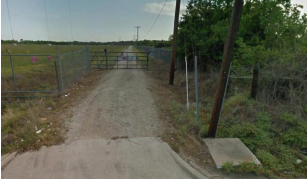
Room to pull off the road safely is important
In other words: put the gate far enough from the main road to allow vehicles to exit the thoroughfare so you can open the gates safely but still close enough to make parked vehicles obvious.
No Flimsy Gates
No matter their location and purpose, all gates must be substantially constructed.
Initial driveway gates can be a simple swing bar to restrict vehicle entry. This type of gate should be built and positioned to deny driveway access to vehicles and 4-wheelers / UTVs.
We have found the addition of a few “anti-ram” spikes is a great deterrent for the big bad 4WD truck that might otherwise simply push a gate open with a brush guard. Anti-ram spikes can be as simple as 24-inch lengths of horizontal bar/ pipe/tubing welded to the gate about radiator high. The outward end of the spike is cut at a 45 degree or greater angle to create a nice pointy radiator skewer.
This is installed, of course, on the entry-facing side of the gate.
The permanent main perimeter gates should be swinging or slide gates integrated into the site perimeter fencing. They should be constructed to give the same level of entry protection as the attached fence. Anti-ram spikes are suggested for installation on this gate as well.
Again, tower fence gates must be fitted such that all bolts and clamps are inaccessible to the outside of the fence. And all bolts should be peened or welded.
And be sure to avoid using the flip-up type gate locks often used on chain link fences. They are junk and can be defeated in seconds with a hard push.
Lock and Chain
Multi-lock bars are available for gates and doors but a heavy chain and series of locks is usually effective enough for most sites.
Either way, it is much better to use a substantial lock and chain or a multi-lock latch instead of any standard light duty locking mechanism.
Although some sites do use a single combination lock, it is often necessary to have multiple locks on each gate because of issues with different vendors (utilities, site maintenance, co-located clients, public safety, engineering, etc).
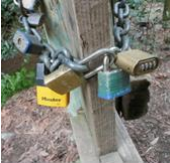
If you must deal with the “chain ‘o locks” whether you control the site or not, do make sure there is a policy to cover the problem when a utility or some other company “jump locks,” locking out another user by bypassing their lock.
Lock Bars
Preventing lock jumping is one of the major benefits of a lock bar – the separation of locks 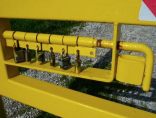 so that one user cannot affect another.
so that one user cannot affect another.
For especially troublesome sites, you may want to check out a version of the multi-lock bar that protects the shackles from bolt cutters.
Just the First Step
It is true that, as the first line of defense, gates and fences certainly can be defeated. However, if properly constructed, they should cause as much delay and work for the intruder as possible.
The main idea is to stop any casual “visitors” and delay the determined ones until other aspects of site security can come to bear.
Looking Ahead
In future installments of F-L-A-P we will address the Lighting, Alarm and Presence methodology that will help you to know that your site is under attack – and what you can do about it when you find out the bad guys are on site.
– – –
By the way: if you have some good stories of the successes you have had in securing your site, we would love to hear them. Share them by clicking here.
Kevin C. Kidd, CSRE/AMD is the proprietor of AM Ground Systems Company and KK Broadcast Engineering. More information on ground systems and security systems can be obtained by calling Kevin at 1-877-766-2999 or visiting his web site at: www.amgroundsystems.com

